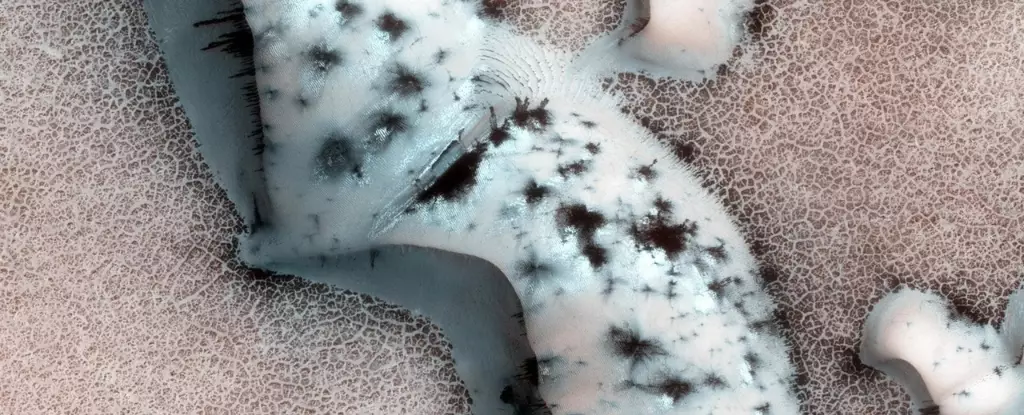Mars, often regarded as the red planet, presents an astonishingly diverse and captivating landscape that challenges our perceptions of beauty beyond Earth. While it is a cold and inhospitable world, stripped of the vibrancy we associate with our own planet, recent explorations have unveiled features that provoke awe. One standout characteristic is its polar regions, blanketed not just in ice, but also in solid carbon dioxide (CO2) during the frigid Martian winter. As temperatures rise with the arrival of spring, a remarkable transformation occurs, illustrating the dynamic processes that govern this distant realm.
Mars experiences a stark seasonal cycle influenced primarily by its thin atmosphere, which is composed overwhelmingly of carbon dioxide—about 95%. When winter descends on the Martian poles, CO2 freezes and accumulates, forming a dense layer that lays dormant for months. As it warms, sunlight penetrates this translucent icy cover, gently heating the ground underneath. This complex interplay of temperature and atmospheric dynamics leads to sublimation, a process where the solid carbon dioxide transitions directly into gas. This gradual buildup of pressure creates potential energy beneath the surface layer, leading to spectacular eruptions of gas and dark materials.
The geysers that erupt during spring are not merely spectacular visual phenomena; they represent significant geological processes at work. Observations from the High-Resolution Imaging Science Experiment (HiRISE) on NASA’s Mars Reconnaissance Orbiter have provided detailed insights into these geysers. Captured in dramatic images, these eruptions can create dark spots that span up to 1 kilometer in diameter and jet out at speeds nearing 160 kilometers per hour. The sheer power of these geysers and their ability to alter the Martian landscape adds layers to our understanding of extraterrestrial geology.
Remarkably, some eruptions can produce unique surface features reminiscent of spider patterns, referred to as araneiform terrain. These groupings of depressions and channels give Mars a distinctive and wrinkled appearance. They are both an enigma and a beauty, sparking scientific curiosity into the underlying mechanics of their formation.
NASA’s scientists have made strides in demystifying the formation of these intriguing geological features. Through laboratory recreations of the Martian conditions, they have developed the Keiffer model, which provides clarity on how the seasonal ice caps contribute to the emergence of CO2 geysers. According to the model, a solid CO2 ice slab forms over time and becomes permeable to the buildup of high-pressure gas beneath. Eventually, the pressure leads to rupture events, creating jets that eject fine particles and reveal the dark patches we can now observe from orbit.
As Lauren McKeown, a researcher at NASA’s Jet Propulsion Laboratory, articulated, these spider-like structures are not just geological oddities; they embody a blend of beauty and scientific intrigue worthy of further exploration.
When contrasting the aesthetic allure of Earth with that of Mars, it’s crucial to recalibrate our definitions of beauty. Earth’s diverse ecosystems, teeming life, and rich colors have inspired countless poets and artists, leading to an almost spiritual reverence for our home planet. However, the geological phenomena unique to Mars, while stark and cold, offer an entirely different perspective. The intricacies of CO2 geysers and the formations they produce stand as reminders of the celestial wonders existing beyond our own environment.
As researchers continue to study the seasonal transformations on Mars and the geysers that captivate our imagination, a deeper appreciation for the planet’s intrinsic value emerges—a beauty that, while different from Earth’s, holds beauty in its own right. It serves as a testament to the complex processes shaping not just planetary bodies but also our understanding of life’s diverse forms across the universe.


Leave a Reply